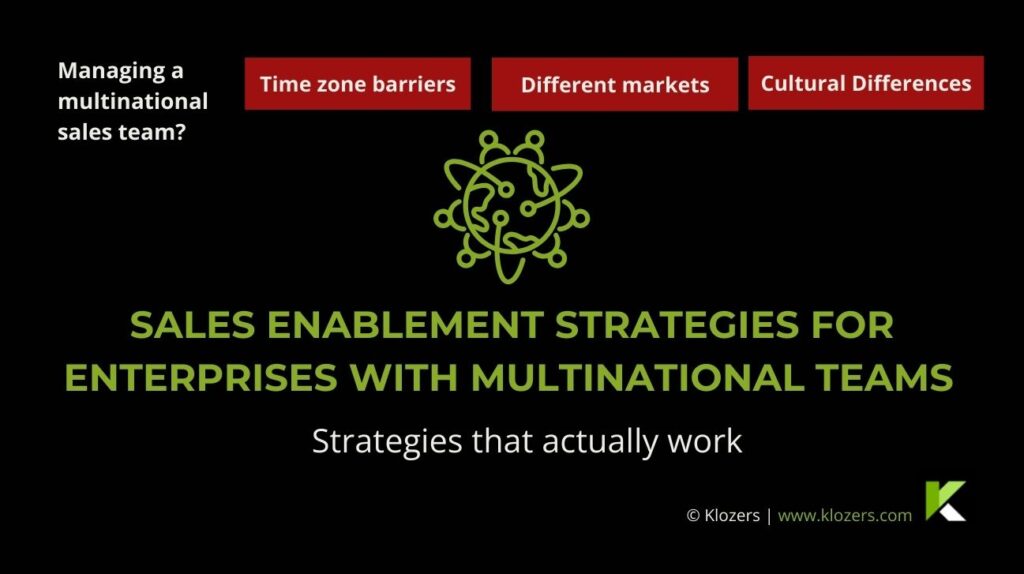Sales Enablement Strategies for Enterprises -Top Question From Google:
What are Sales Enablement Strategies?
Sales enablement strategies are the methods companies use to help their sales teams sell more effectively. These strategies include providing training, tools, content, and support that help salespeople connect better with customers and close more deals.
Free access to our best tools and templates
Introduction
Sales enablement is highly important for businesses today, and statistics support this notion. The sales enablement market was valued at $5.23 billion in 2024 and is projected to grow by 16.3% from 2025 to 2030, which shows how much companies are investing in better sales support systems.
However, companies operating in many countries face several challenges when implementing sales enablement for their teams. It requires balancing global consistency with local market needs as well as managing cultural and time zone differences.
This article discusses practical strategies for creating sales enablement programs that drive results across international markets.
Develop a Flexible Global Sales Framework
Building a sales framework that works across different countries means creating a structure without being rigid. Your framework should start with the core elements that drive success everywhere. These might include how you qualify prospects, the key questions you ask during discovery calls, or the information you need before proposing a solution. These elements stay consistent because they form the basis of how your company creates value for customers.
But the way you apply these elements should change based on local markets. In some cultures, building personal relationships comes first, and the business conversation happens later. In others, people want to get straight to the business case and see personal chat as a waste of time. Your framework needs to accommodate both approaches while ensuring that the same important information gets gathered either way.
Implement Integrated Technology Solutions
Technology can either connect your global teams or create more silos, depending on how you approach it. The goal is to have systems that help people work together and share information seamlessly.
Start with your customer relationship management system. This needs to work the same way for everyone, but it should also be flexible enough to capture the different types of information that matter in different markets. How your team in Japan manages customer relationships might be different from how your team in Germany does. The same CRM should handle both needs without forcing either team to work in unnatural ways. The same goes for other tech like communication tools, content creation tools, and more.
The best technology implementations also include mobile-first thinking. Your teams are traveling, working from home, or meeting with customers outside the office. They need access to the same information and capabilities, whether they’re at their desk or in a customer’s conference room in another country.
Design Scalable Training Programs That Address Cultural and Market Differences
People learn differently across cultures, and what motivates one group might not work for another. Your training program needs to deliver consistent core content while adapting to different learning styles and cultural preferences.
Build your training curriculum around core competencies that apply everywhere, then layer on market-specific elements. Everyone needs to understand your value proposition, product capabilities, and sales methodology. But teams also need training that addresses the specific challenges and opportunities in their markets.
Consider delivery methods that work across different time zones and cultural preferences. Some regions prefer in-person, interactive training sessions, while others are more comfortable with self-paced online modules. You might need to offer multiple formats for the same content to ensure everyone can engage effectively.

Establish Global Performance Standards with Regional Flexibility
Start by identifying the performance indicators that truly matter for business success. These might include deal velocity, customer satisfaction scores, or quota attainment. But think carefully about how you measure these indicators and whether the same metrics make sense across all markets.
Deal sizes might vary between regions based on local market conditions, purchasing power, or business customs. Your team in a developing market might close many smaller deals that require the same effort as the large deals your established market team pursues. This means raw revenue numbers cannot tell the complete story of who’s performing well.
Sales cycle length can vary based on cultural factors and business practices. In some regions, relationship building extends the initial phases of the sales process, but leads to faster decision-making once trust is established. In others, buyers move quickly through initial stages but require extensive evaluation and approval processes before committing.
Create performance standards that account for these regional differences while still driving the behaviors you want to see. You might use market-adjusted quotas, region-specific conversion rate expectations, or local competitive benchmarks rather than applying the same numbers everywhere.
Build Effective Communication Systems Across Time Zones and Cultures
Communication across global teams requires intentional systems and processes that don’t rely on everyone being available at the same time. You need to create ways for information to flow smoothly, even when teams are working while others sleep.
Develop communication rhythms that work across time zones. This might mean having rotating meeting times so the burden of early morning or late evening calls gets shared. Or it might mean allowing communication outside office hours for routine updates and reserving real-time meetings for situations that truly require that.
It is also important to know that cultural communication styles vary and can create misunderstandings even when everyone is on the same page. Direct feedback that seems normal in one culture can feel harsh or disrespectful in another. Similarly, indirect communication that feels polite in some cultures can seem evasive or unclear to others.
Train managers on cross-cultural communication and give them tools for adapting their communication style to different team members. This includes understanding how different cultures handle disagreement, give feedback, and express concerns or problems.
Address Implementation Challenges and Cultural Resistance
Change management can be challenging when you’re implementing new systems across different cultures and markets. What looks like resistance might be confusion, cultural mismatch, or practical barriers that you haven’t considered.
70% of cross-border mergers and acquisitions fail to achieve their intended synergies, often due to cultural mismatches, according to a study by McKinsey & Company. This statistic highlights how challenging it is to align different business cultures, and sales enablement implementations face similar challenges.
To handle this, you need to identify potential cultural barriers early in your planning process. Some cultures are more hierarchical and may need different management approaches than cultures that value consensus and group decision-making.
You can also provide different paths for teams to get support during implementation. With time zone differences, teams might need help when your central support team isn’t available. Create support resources that work asynchronously or train local staff who can provide immediate help.
Actionable Tip:
When rolling out sales enablement across multiple countries, appoint local champions in each region. These are trusted sales reps or managers who adapt global frameworks to local realities, gather feedback, and drive adoption. This builds ownership, reduces resistance, and ensures your strategy feels relevant in every market.
Want me to give you a couple of alternative shorter punchy versions too, so you can use one in the article and another on social when promoting it?
Final Thoughts
Sales enablement for multinational teams requires thinking differently about how people work, communicate, and build relationships across cultures and time zones. Companies need to understand that they need to maintain brand identity globally without losing local relevance in each country they operate in.
Remember that building effective multinational sales enablement is not a one-time thing. Markets change, teams evolve, and new challenges emerge. The companies that continue to succeed are the ones that stay curious about what’s working and what isn’t, and remain willing to adapt their approaches based on what they learn.







